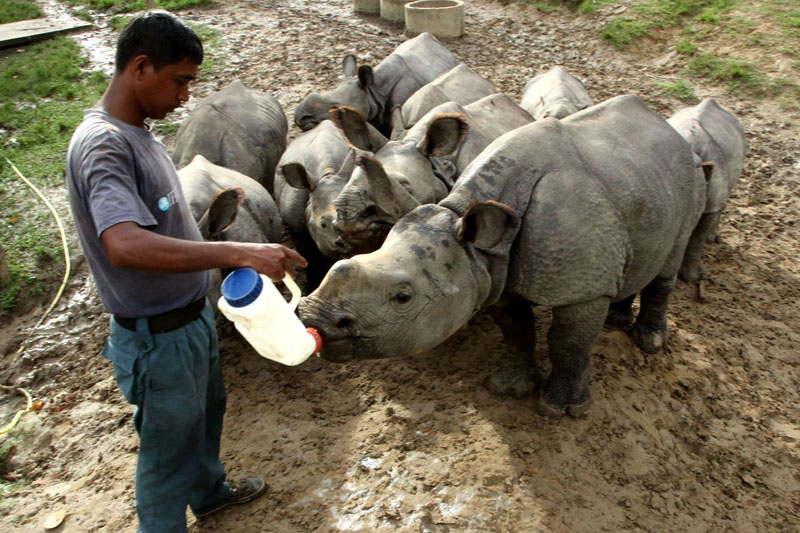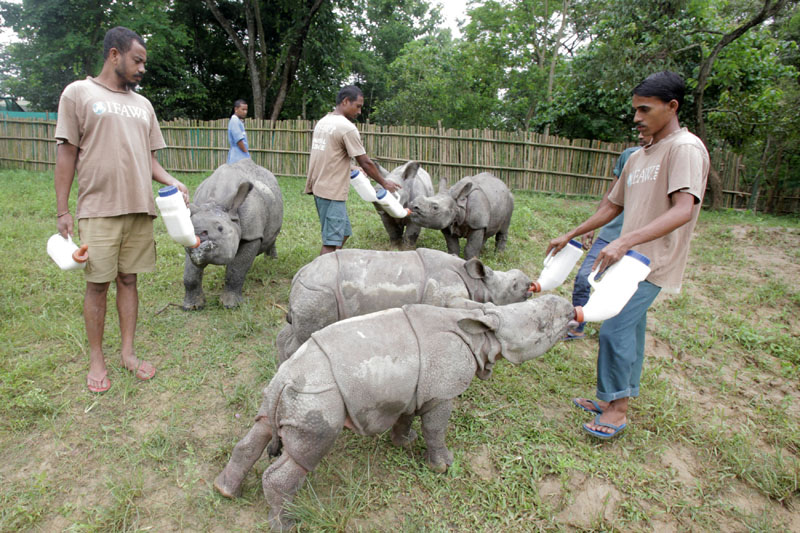Growing Wild: the rescued rhino calves
It’s been a year since Kaziranga National Park was inundated by the worst floods to have hit Assam in over a decade. Among the 100-plus wild animal emergencies that CWRC (the Centre for Wildlife Rehabilitation and Conservation: the wildlife rescue, treatment and rehabilitation centre run by Wildlife Trust of India (WTI), the International Fund for Animal Welfare (IFAW) and the Assam Forest Department near Kaziranga) and its Mobile Veterinary Service units attended during the floods last year, were eight orphaned rhino calves that were rescued and brought to the centre to be hand-raised.
The simultaneous long-term care of eight rhinos has been a massive challenge for the team at CWRC. In addition to the efforts of the centre’s animal keepers and veterinarians, the tremendous support received from individual and corporate supporters, the Government of Assam, the Kaziranga National Park Authority and people from all walks of life across Assam has been critical.
“I remember that a group of children from a remote school had given up a mid-day meal to buy milk formula for the rhino calves”, says Dr Rathin Barman, WTI Joint Director and centre-in-charge, CWRC. “There have been several such touching expressions of support. We extend our heartfelt gratitude to the people of Assam and all well-wishers for their support and encouragement over the past year.”
When the rhino calves were first brought to CWRC they were stabilised at the centre’s Large Animal Nursery. Once they had recovered from their flood-related trauma and injuries they were shifted to a small outdoor paddock attached to the nursery. Gradually, having acclimatised to the outdoors, they were introduced to three larger paddocks with a natural stream running through them. This allowed the calves to wallow and play – an important part of their natural developmental behaviour.
“The calves have grown fast”, says Dr Panjit Basumatary, the lead veterinarian at CWRC. “Importantly, they’ve experienced all four seasons now, in an approximation of their natural habitat. It was touching to see how the younger calves huddled close to the older ones at night to keep warm during the winter, as they would have with their mothers. Now, as they play in the mud, enjoy the rain or nap together as they would in their natural environment, we feel a sense of satisfaction that they are making good progress towards a life in the wild.”
CWRC currently has ten rhino calves under care. The eight calves rescued last year had already bonded with an older calf that was rescued in 2015. Another under care four- to six-month-old calf displaced by the monsoon floods was rescued from Burhapahar and brought to the centre earlier this month during Kaziranga flood 2017.
Other Contents by Author
‘Jamuna’, a female rhino that had been rehabilitated into the wild by Wildlife Trust of India (WTI), the International Fund for Animal Welfare (IFAW) and the Assam Forest Department in 2010, has given birth to her second calf in Manas National Park, the UNESCO World Heritage Site, on Sunday morning. The calf was first seen by frontline forest staff of the Bansbari Range during their early morning patrol. Its presence was later confirmed by a field team of IFAW-WTI’s Greater Manas Conservation Project, comprising Dr Bhaskar Choudhury, WTI's Head Veterinarian (North East) and the project-in-charge, and animal keeper Debajit Saikia. “This is the sixth calf born to the rhinos rehabilitated...
A convention of the Asian Elephant Specialist Group (AsESG), the IUCN (World Conservation Union) Species Survival Commission’s voluntary group of experts for the management and conservation of Asia's elephants, will get underway at Guwahati on November 10-12. The three-day convention will be attended by representatives of 11 Asian elephant range countries as well as presenters and observers from ‘non-elephant’ countries like the United Kingdom and United States of America.
Dr Dhrubajyoti Borah, President, Asam Sahitya Sabha, released the Poetry special issue of Eka Ebong Koekjan, the foremost Bengali literary journal from North East, before an august gathering of writers and intellectuals at Karmasree Hiteswar Saikia Auditorium, Pandu on Sunday. Dr Borah lauded Eka Ebong Koekjan for its untiring efforts through 37 long years to disseminate the richness and diversity of the literature of Assam and the North East to the greater Bengali diaspora. He said that literature has a unifying and harmonising role to play in building up a greater Assamese society incorporating diverse linguistic and ethnic groups in its fold. He defined ‘Asomiya’ as one who is...
Mobile Veterinary Service (MVS) units of the Centre for Wildlife Rehabilitation and Conservation (CWRC) – the wildlife rescue, care and rehabilitation facility jointly run by Wildlife Trust of India (WTI), Assam Forest Department (AFD) and International Fund for Animal Welfare (IFAW) – have attended 107 wildlife rescue cases in the ongoing flood crisis in Kaziranga National Park as of August 1. Kaziranga, one of India’s UNESCO world heritage sites, has faced a major wildlife crisis this year due to what are being described as the worst floods in a decade. As large areas of the park are inundated in the annual monsoon floods, wild animals seek higher ground across National Highway 37...
Pramila Rani Brahma, Environment and Forests minister of newly formed Assam government visited Centre for Wildlife Rehabilitation and Conservation (CWRC), the wildlife care facility jointly run by Assam Forest Department, Wildlife Trust of India (WTI) and International Fund for Animal Welfare (IFAW) as part of her two-days visit to Kaziranga National Park on Thursday.
Their Royal Highnesses William and Catherine, Duke and Duchess of Cambridge, this afternoon visited IFAW-WTI’s Centre for Wildlife Rehabilitation and Conservation (CWRC) near Kaziranga National Park, Assam. CWRC, run by the International Fund for Animal Welfare (IFAW) and the Wildlife Trust of India (WTI) with support from the Assam Forest Department, is the only facility in India where orphaned and/or injured wild animals of several species are hand-raised and/or treated and subsequently returned to the wild. As of March 2016 the Centre had handled 4,322 animal cases, with 2,465 being released back to the wild – a rehabilitation rate of nearly 60 percent. Their Royal Highnesses...
Ashok Kumar, Founder & Chairman Emeritus, Wildlife Trust of India (WTI) was honoured with the Sanctuary Legend Award at the prestigious Earth Heroes event held at NTPA auditorium in Mumbai today. The Legend Award is a new honour started by Sanctuary this year. With a career in wildlife spanning over five decades Ashok Kumar’s contribution to conservation is immeasurable. A pioneer in many ways, he has a strong hand in ensuring that Sansar Chand, the most dangerous wildlife trader ever to have operated in India, stayed behind bars. He set up TRAFFIC in India and conducted a milestone seizure of tiger derivatives during his tenure there. At a time when nobody spoke about seeking...
In a first of its kind sensitization programme on Asiatic black bears, 14 youth from Shergaon - a small but important area in Arunachal Pradesh – were taken on an exposure visit to IFAW-WTI run Centre for Bear Rehabilitation and Conservation (CBRC) in Pakke Tiger Reserve. At CBRC, the visitors were briefed about the importance and need for conservation of wildlife and bio-diversity in Arunachal Pradesh. Shergaon falls in the West Kameng district of Arunachal Pradesh and the residents are predominantly Sherdukpten, a tribe Buddhist by religion. To effectively spread the message of wildlife conservation among the villagers of Shergaon, IFAW-WTI partnered with a local NGO named Garung Thuk....
In a covert operation assisted by WTI, Hari Singh and Munni, husband and wife, were apprehended in Gwalior and 27.5 kgs of pangolin scales were seized from them. It is a huge development in busting the pangolin trade racket since they are a crucial link to the trade that has been flourishing for the last few years. Madhya Pradesh Forest Department (MPFD) in co-operation with Wildlife Crime Control Bureau (WCCB) was able to apprehend the accused after a regular and steady surveillance using phone and modern tracking devices. Pangolin scales are high on demand for various reasons and the trade has been going on for several years. However, this has been the first major development in busting...
Debjani Patikar, a Guwahati based journalist with Purvanchal Prahari is awarded “Best Female Correspondent” by The Newspapers Association of India (NAI) at 23rd NAI National Achievement Awards -2015 held in New Delhi recently. She was awarded by the NAI for her contribution to print media in Assam since 2001. The award ceremony was held at NDMC Convention Centre in New Delhi on 28th November 2015. Apart from her regular contributions to the dailies and periodicals, she has also worked on various projects in the state. Presently she is engaged as a researcher of “India –Bangladesh History Project for Documenting Bangladesh Liberation War 1971” from Assam. NAI aims to...











Add new comment